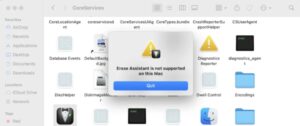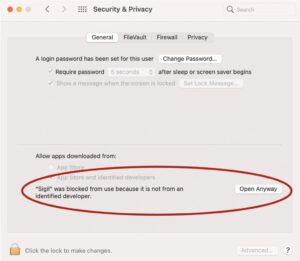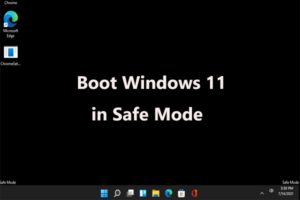Windows users frequently experience the 0x80004005 error code, a common issue that anyone can experience. Various factors, including incorrect configuration settings, outdated or corrupt drivers, and malware or virus infections, can be a vital cause of this error.
In today’s article, we will explore the causes of the 0x80004005 error code and provide solutions for fixing this error.
We will also cover additional topics such as system restoration, updating and reinstalling drivers, and running a full system scan, which will help you eliminate malware and this error.
This article will provide tailored solutions to fix this error code, which can frustrate Windows users.
Understanding windows error 0x80004005
Windows error 0x80004005 is an unspecified error which occurs under several circumstances in Windows systems. Don’t worry it is a common but sometimes frustrating error as it does not showcase specific details about the issue. However, the error code 0x80004005 is usually related to problems with file or folder access, windows updates or issues with device drivers.
You can experience this error while accessing shared files or folders, files from an archive, renaming folders or even while updating your Windows operating system.
However, there is no specific reason for this error but still, you can take several steps to pinpoint and resolve this issue.
Whenever you encounter this 0x80004005 error, the first step is to assess the situation and understand why this error appeared. For example, the error during a windows update will hint towards an issue related to system files or configuration settings.
In other cases such as while accessing files or folders the error 0x80004005 can be related to security issues or settings on your system.
Otherwise, the file or folder you are trying to access is incompatible. Checking the security settings and ensuring the correct access permissions can help you to fix this error.
It is crucial to stay confident and patient while troubleshooting this error 0x80004005. As we know this error is unspecific it might take some attempts and time to address the root cause of this error.
After understanding the context in which the error arises, you can follow the appropriate steps and confidently resolve the Windows error 0x80004005 and get your system running smoothly again.
Causes of the “0x80004005” error code
Like other errors in Windows, the “0x80004005” error code can be caused by several factors. These include:
Incorrect configurations: In some cases, installing new applications makes changes in the registry, or changing settings manually will lead to incorrect configuration settings. Thus, restoring your previous configurations or manually resetting the affected settings will fix this issue.
User permissions: If your Windows user account does not have ownership of the file or folder or lacks proper access permissions, this might be a vital cause of this error.
Archive files: This error can occur if you are trying to open an encrypted archive file without appropriate software, such as a ZIP file.
Malware: Malicious programs can corrupt the system files and cause issues to the operating system, which will result in this error code.
Virtual machine and network issues: If you are encountering an error while using a virtual machine such as VirtualBox or with network adapters, then updating drivers or reinstalling the Microsoft adapters can help you fix the issue.
File and folder issues: Files and folder permissions can lead to this error in File Explorer. Check if you have all the required permissions to access the file or folder causing the error.
Additionally, the shared folder configurations can lead to the 0x80004005 error. So, always, double-check the settings and make all the necessary changes.
Windows update issues: Sometimes, the error 0x80004005 occurs due to issues related to Windows updates. Make sure your Windows operating system is up to date. To do so open settings go to update and security and, “check for updates.”
If any update is available then install it and restart your system. Using the Windows update troubleshooter can help you to identify and resolve the issue.
Now that we know the possible cause of the 0x80004005″ error code, let’s look at solutions for resolving it.
How to fix the “0x80004005” error code on windows
In the following section of the article, we will look at the solutions that can be used to troubleshoot and fix the “0x80004005” error code on your Windows system.
Solution 1 Check for the archive errors
Archive files are beneficial for compressing files; hence, they take up less space by bundling multiple files into one package. It will encrypt the documents and will split large files into small pieces.
Microsoft’s File Explorer can open ZIP archives, but it cannot open advanced file formats like RAR or 7Z. Even the support for the ZIP format Is limited here.
So, if you want to do more advanced things, such as encrypting the files or trying to open an encrypted ZIP file, then while using File Explorer, you will get the “0x80004005” error code. This means that the program cannot handle the encrypted files.
To fix these, you can use other applications that can open encrypted archive files. There are many programs which can help you. Some applications, such as 7-Zip and PeaZip, are available online for free. There are several other applications, but they will cost money after the trial period is over.
Solution 2: Use windows update troubleshooter
Windows comes with a built-in troubleshooter, which will help you to diagnose and fix issues related to Windows Updates. Here are the steps to use it and fix the “0x80004005” Error Code on Windows.
Step 1: Open the settings app on your Windows system. You can open it by clicking the start menu and the gear icon. You can also use the Windows + I keyboard shortcut to open it.
Step 2: Click on the “system” on the right side of the menu and select the “Troubleshoot” option.
Step 3: Now, click on “Other troubleshooters.”
Step 4: Under “Most frequent,” click on “Windows Update” and then click on the “Run” button.
Step 5: The troubleshooting will start scanning your system for any issues related to Windows Update. You need to simply follow the on-screen instructions to resolve the problems.
Step 6: Once the troubleshooting is done, restart your device to ensure that any changes made take effect.
Note: The steps mentioned above will work for Windows 11, but the steps may vary slightly if you are using an older version of Windows.
Solution 3: Configuring network discovery and sharing settings.
Troubleshooting the networked devices can be challenging as issues related to network discovery and sharing settings are mostly the primary cause. To fix these settings, you need to access the network settings.
You can do this by clicking the start button and searching for “advanced sharing option.”. Click on the “Open” button. Once you have accessed the sharing settings, you can customize them based on the network type you are connected to.
It is highly recommended that you set your home network as private. To complete the process, select the check boxes corresponding to “Turn On Network Discovery,” then “Turn on Automatic Setup of Network Devices,” and “Turn on File and Printer Sharing.”
Solution 4: Change the NetBIOS settings
If your NetBIOS is not functioning correctly, it can be the main culprit for the error 0x80004005. It is among the vital components while connecting devices over a Local Area Network, so make sure you have everything up to date and running correctly.
Step 1: The first step is to access the search interface of your taskbar and then enter “Network Connections” into the search bar.
Step 2: Click the Open button on the matching search result.
Step 3: To see your network adapter’s properties, just right-click on it and choose properties from the context menu. A wired connection is titled “Ethernet,” and the wireless adapter is titled “Wi-Fi.”
Step 4: Search for “Internet Protocol Version 4 (TCP/IPV4)”. Select it and then click on the Properties button. A new settings window will appear on the screen.
Step 5: Now, click on the Advanced button.
Step 6: Switch to the “WINS” tab. If your NetBIOS is disabled, then switch it to the Default setting. However, if the id “Default” is already selected, you will get a 0x80004005 error. Try changing it to “Enable NetBIOS” instead.
Step 7: Click the OK button and check if you still experience the 0x80004005 error on the screen.
Solution 5: Check your SMB settings
SMB protocol will allow devices on the same network to function like clients and servers. If your SMB settings are not configured correctly or have specific issues, then you can perform the below steps to fix them.
Verifying SMB Service Status
Step 1: First, press Windows + R on your keyboard, enter “cmd,” and press ctrl + shift + Enter to launch the command prompt.
Step 2: Now, execute the command “sc.exe qc lanmanworkstation.”
Step 3: Check that “START_TYPE” is set to “AUTO_START.” Otherwise, execute the following two commands in the same window:
- = bowser/mrxsmb10/mrxsmb20/nsi
- sc.exe config mrxsmb20 start= auto
Step 4: If successful, you will see” [SC] ChangeServiceConfig SUCCESS.”
Enable Insecure Guest Logins
If the above solution doesn’t work, enabling insecure guest logins is the next step.
Step 1: In the first step, press Windows + R on your keyboard and enter “regedit.” Then press OK to launch the Registry Editor.
Step 2: Now Access the “HKLM\SYSTEM\CurrentControlSet\Services\LanmanWorkstation\Parameters” key by either navigating to it on the left menu or copying and pasting the path into your address bar.
Check if you have an AllowInsecureGuestAuth DWORD value. If you already have a value, continue with the following method.
Simultaneously, if the value is not present, then right-click on any empty space and, choose New > DWORD (32-bit) Value, and name it “AllowInsecureGuestAuth.”
Step 3: Double-click on the newly created value and set the data value to 1. Now, click on the OK button to validate the change.
After performing this method, check whether the 0x80004005 error still occurs.
Switch To SMBv1
Even though SMBv1 is disabled on Windows 10 and 11, you can still reactivate it if your network device requires it.
Step 1: You get two options to access the Windows Feature settings. You can enter “Windows Features” in your search box and click Open. On the other hand, you can go to Control Panel >Programs and Features> Turn Windows Features On or Off.
Step 2: Now, search for SMB 1.0/CIFS File Sharing Support in the list and click its plus button to open further options.
Step 3: Tick the “SMB 1.0/CIFS Client” and “SMB 1.0/CIFS Server” from the options list.
Step 4: Now, uncheck “SMB 1.0/CIFS Automatic Removal” and click OK to finalize the changes.
Solution 6: Turning On essential services
To ensure the optimal function of your network sharing, ensure the following Windows services are enabled appropriately. Here are the steps to perform.
Step 1: Press the Windows + R keys on your keyboard first. This will get you to Run the utility box. Enter “services.msc” and click on the OK button. This will launch the services window.
Step 2: To enable a service, right-click on its name and select properties. Use the startup type drop-down menu in the new window and set it to Automatic.
Step 3: Perform these steps for all the following services
- DNS Client
- DHCP Client
- Function Discovery Provider Host (fdPHost)
- Function Discovery Resource Publication (fdResPub)
- Simple Service Discovery Protocol (SSDP)
- UPnP Device Host
Step 4: After enabling these services, restart your system and check if the 0x80004005 error code is still active.
Solution 7: Disabling IPV6
The following generation of internet protocol, IPV6, popularly known as Internet Protocol version 6. However, transitioning to this new standard comes with some challenges, and disabling IPV6 might solve the 0x80004005 error.
Step 1: Firstly, open the Settings app on your Windows device. You can do this by clicking on the Start menu and clicking the icon. On the other hand, you can open it by pressing the Windows + I keyboard shortcut.
Step 2: Click on the “Network & internet then click on your network properties (Ethernet or Wi-Fi). Now, click on the Edit button and the DNS settings section.
Step 3: Make sure the IPV6 toggle is turned off.
Step 4: After making the changes, restart your system.
Solution 8: Fixing the user permissions
If you’re still getting the 0x80004005 problem when managing local files, it’s likely due to a permissions or ownership issue. Here’s how to fix it.
Step 1: The first step is to search for the file you are having the issues with, right-click to open the context menu, and choose Properties from the drop-down list.
Step 2: A new window will appear on the screen. Now, switch to the Security tab and click on the Advanced button.
Step 3: Click on the “Change” option next to the file’s current owner. You will need administrative rights to do this.
Step 4: Provide your account name in the “Enter the object name to select” field, then click the Check Names button. The system will automatically input the fill name. Once done, click on the OK button.
Step 5: Stay on the security tab in the properties window and choose the Users group. Click on the Edit button and then ensure Full control is allowed.
Step 6: The last step is to click on the Apply button.
Solution 9: Run a full system scan
If the “0x80004005” error is caused by malware or virus, then a full system scan will fix the issue.
Solution 10: Temporarily disable your antivirus
Antivirus protects your device from viruses and threats; sometimes, these applications can detect false positives and block legitimate files from opening. This often leads to errors like 0x80004005.
If you think your antivirus is responsible for this error, try disabling it temporarily and check whether the issue is resolved. If this resolves your problem, you can search for an alternative antivirus solution or how to whitelist your file from being blocked.
Conclusion
Although the 0x80004005 error is a common problem in Windows systems, it can usually be fixed with simple fixes.
In this article, we have discussed 10 solutions for troubleshooting and improving the 0x80004005 error code. But if you still get this error, contact customer support or a system administrator to fix this issue.







